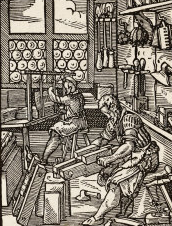"How the peple schulde don worchepe aforn the image & nout to the ymage." Views exchanged on the seduction of devotional images in Dives and Pauper
Keywords:
Moyen-âgeAbstract
Summary:
Dives and Pauper is an anonymous prose explication of the Decalogue written at the beginning of the 15th century in England in the wake of the lollard attacks on the abuses of the Church and its taste for riches and images conducive to idolatrous practices. Not long before the composition of the work, Wycliff and his followers had deplored the growing number of seductive pictorial evocations of Christ, the Virgin Mary, and the saints. The two eponymous disputants, a rich layman and a poor preacher, discuss the role, meaning, and effect of devotional images. The risk is that the beholder of such attractive visual incentives for religious fervour might be deluded into worshipping the picture instead of the hypostasis (or holy entity represented). The primarily catechetical and liturgical purposes of images of the cult might be overlooked by believers overly sensitive to their ornamental quality or likely to lend them some thaumaturgical powers. In addition, images tend to invite for the making of offerings to churches and the purchase of indulgences with a view to securing afterlife salvation. The article examines clerical and lay viewpoints expressed in Dives and Pauper on the seduction of artistic images that potentially threaten to lead the praying Christian astray both in mind and conduct. The right balance between iconodulism and iconoclasm is hard to reach, as the colloquy tends to prove.
Résumé :
Dives and Pauper est un long commentaire anonyme en prose du Décalogue, écrit au début du XVe siècle en Angleterre dans le sillage des critiques émises par les Lollards au sujet des abus de l’Église et son goût des richesses et d’images incitant à un comportement idolâtre. Peu de temps avant la composition de cette œuvre, Wycliff et ses partisans avaient déploré la prolifération des évocations picturales du Christ, de la Vierge Marie, et des saints. Les deux interlocuteurs de la disputatio, un laïc aisé et un prêcheur sans le sou, débattent du rôle, de la signification, et de l’effet des images de dévotion. Le risque est que le regardeur de ces figurations visuelles attrayantes qui stimulent la ferveur religieuse soit amené à vénérer l’image plutôt que son hypostase (ou entité sacrée représentée). Les fonctions principalement catéchistique et liturgique des images du culte peuvent être ignorées par les croyants trop sensibles à la dimension ornementale d’images auxquelles ils prêtent parfois des vertus thamaturgiques. Par ailleurs, les images invitent souvent au don d’offrandes aux églises ainsi qu’à l’achat d’indulgences en prévision du salut éternel. L’article se livre à un examen des points de vue aussi bien clerical que laïque exprimés dans Dives and Pauper sur la séduction de représentations visuelles artistiques susceptibles de leurrer le chrétien en prière, en pensées comme en actes. Il est malaisé d’atteindre le juste milieu entre iconodulie et iconoclasme, ainsi que le dialogue tend à le montrer.Published
Issue
Section
License
- Work submitted for publication must be original, previously unpublished, and not under consideration for publication elsewhere. If previously published figures, tables, or parts of text are to be included, the copyright-holder's permission must have been obtained prior to submission.
- Authors of accepted manuscripts will assign to L'Atelier the right to electronically distribute their article, or publish it in any form (Internet, CD ROM, printed copy) but authors will retain copyright and, after the article has appeared in L'Atelier, authors may republish their text (in print and/or electronic form) as long as they clearly acknowledge L'Atelier as the original publisher.


